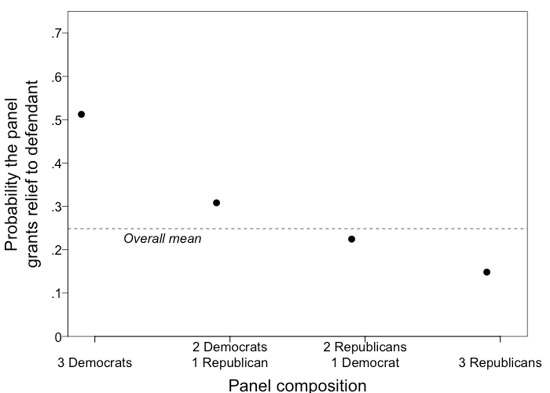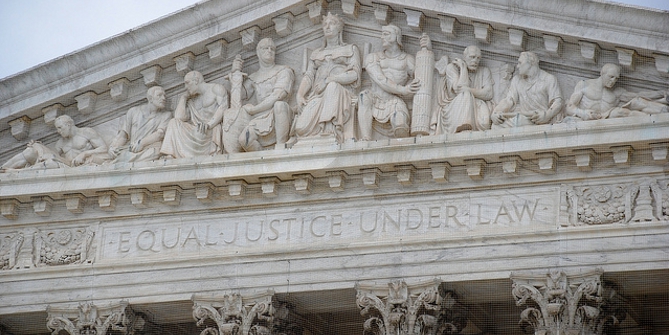
 A recent spate of apparently botched executions has once again brought the death penalty and defendants’ appeals against their sentences into the spotlight. But are decisions about sentences made consistently across the federal judiciary? By examining over 1,400 death penalty decisions made by three-judge panels over a thirty year period, Deborah Beim and John Kastellec find that panels with three Democratic judges are much more likely to grant relief to a defendant than panels with even a single Republican. This apparent problem of consistency is mitigated, however, by the institutional features of the federal courts. In particular, judges can dissent from decisions they disagree with, which can serve as a signal to higher courts that the panel’s decision warrants a review. Since most death penalty cases are heard in Republican-controlled circuits, this means that there is greater oversight of liberal decisions, and greater consistency in the law.
A recent spate of apparently botched executions has once again brought the death penalty and defendants’ appeals against their sentences into the spotlight. But are decisions about sentences made consistently across the federal judiciary? By examining over 1,400 death penalty decisions made by three-judge panels over a thirty year period, Deborah Beim and John Kastellec find that panels with three Democratic judges are much more likely to grant relief to a defendant than panels with even a single Republican. This apparent problem of consistency is mitigated, however, by the institutional features of the federal courts. In particular, judges can dissent from decisions they disagree with, which can serve as a signal to higher courts that the panel’s decision warrants a review. Since most death penalty cases are heard in Republican-controlled circuits, this means that there is greater oversight of liberal decisions, and greater consistency in the law.
On July 23rd, 2014, the state of Arizona executed Joseph Wood for the 1989 murder of his girlfriend and her father. The execution generated headlines because it was the latest in a series of apparently botched executions in the United States administered via lethal injection. But before Wood was executed, a three-judge panel of the federal Court of Appeals temporarily granted him a reprieve, ruling that Arizona’s refusal to inform Wood about the type of drugs to be used in his execution violated his constitutional rights. However, one judge on the panel dissented, arguing that Wood possessed no such right to this information. The United States Supreme Court agreed with the dissenter’s position, and quickly allowed Wood’s execution to proceed.
This case illustrates three important features of federal courts that we examine in recent research. First, cases on the Courts of Appeals are heard by panels of three judges. Second, judges on these panels can dissent from decisions they disagree with. Third, higher courts can review decisions made by three-judge panels. These three features interact to increase consistency in the federal judiciary. This is particularly important in death penalty cases, given the importance of the judiciary in ensuring the death penalty is not applied in an arbitrary or capricious manner.
We examined over 1,400 death penalty decisions made by three-judge panels on the Courts of Appeals between 1983 and 2012. We find that ideological diversity plays a large role in the outcome of death penalty cases. Cases on the Courts of Appeals are heard by panels of three judges, who are randomly assigned to hear the case. Judges appointed by Republican presidents tend to be more conservative than those appointed by Democratic presidents. Figure 1 shows the likelihood of a three-judge panel granting relief to a defendant depending on its composition.
Figure 1 – Composition of appellate panel and probability of defendant relief

We can see that there is an enormous difference in the probability that a panel with three Democratic appointees upholds a death sentence compared to a panel with three Republicans. Such a discrepancy poses challenges for the ideal of consistency in the law—it would be problematic for the rule of law if random assignment determined the outcomes of a large number of cases.
But the graph also shows that “mixed panels”—those with at least one judge from each party—are more likely to produce “majority-inconsistent” decisions. These are decisions less in line with the preferences of the ideological majority on a panel. As it turns out, a defendant on death row only has a 50 percent chance of winning relief from a panel when he is lucky enough to draw three Democratic appointees via random assignment—a rare occurrence due to the conservative tilt of the circuits hearing such cases in our period of study. Thus, it is clear that panel composition affects judicial decision making. Adding just one Republican judge to the panel decreases the probability the panel grants relief to 31 percent. Panels with two Republican judges and one Democratic judge rule for the defendant 22 percent of the time; unified Republican panels only 15 percent of the time. This means that there is much more consistency in decision making across cases than if these appeals were heard by just one judge (as is the case with trial court decisions).
Why do judges affect one another’s decision-making so strongly? In many countries, multimember appellate courts issue collective opinions, thereby preventing judges from writing separate opinions (such as dissents) that argue against the decision and reasoning of the majority. In the United States, by contrast, separate opinions are possible—judges on multimember panels may dissent (or concur) when they disagree with either the result or rationale offered by their colleagues. And indeed, we find that the patterns of dissent are consistent with such a theory. When judges in the ideological minority seem to have persuaded their colleagues, they do not dissent.
This, in turn, means that when dissents are written, they serve as a signal to higher courts that review of a panel’s decision may be warranted. Higher courts that wish to reserve review for cases where it is most important can cue off judges’ dissents. One such higher court is the Supreme Court, as occurred in the Arizona case. Another option is that circuits of the Courts of Appeals can decide to review panels’ decisions. In this procedure, known as en banc review, all of the judges on a circuit sit together to decide the case again. We find that full circuits are more likely to review cases with dissent that signal possibly “wrong” decisions by panels with a majority of judges who are a minority of the circuit (e.g. a majority-Democratic panel in a majority-Republican circuit.) Figure 2 shows the probability that a case is reviewed en banc, depending on the proportion of Republicans on a circuit and whether the panel granted the defendant relief or not.
Figure 2 – Probability of en banc review based on number of Republicans on circuit and defendant relief

Republican-controlled circuits are much more likely to review dissents that signal possible “liberal non-compliance” by Democratic majorities—that is, grants of relief— than they are to review dissents that signal possible “conservative non-compliance” (denials of relief). The opposite is true for Democratic-controlled circuits. But, because most death penalty cases have been heard in Republican circuits, the overall effect is to increase oversight of liberal decisions.
Indeed, over the last three decades, the federal judiciary, led by the Supreme Court (and also aided by shifts in federal law) has made it increasingly difficult for capital defendants to gain relief from the courts. This conservative tilt in the law meant that Joseph Wood’s reprieve from his execution was only fleeting. Whether this is a good or bad thing depends on one’s normative view of capital punishment. But, from a positivist standpoint, it is clear that the institutions of the federal judiciary work to increase consistency across a vast and diverse judicial hierarchy.
This article is based on the paper “The Interplay of Ideological Diversity, Dissents, and Discretionary Review in the Judicial Hierarchy: Evidence from Death Penalty Cases”, forthcoming in the Journal of Politics.
Featured image credit: Shawn Calhoun (Flickr, CC-BY-NC-2.0)
Please read our comments policy before commenting.
Note: This article gives the views of the author, and not the position of USApp– American Politics and Policy, nor of the London School of Economics.
Shortened URL for this post: http://bit.ly/1u14aYZ
______________________
 Deborah Beim – Yale University
Deborah Beim – Yale University
Deborah Beim is an Assistant Professor in the Political Science department at Yale University. She studies American politics in general and judicial politics in particular, with a focus on interactions between the U.S. Supreme Court and the Courts of Appeals.
_
 John Kastellec – Princeton University
John Kastellec – Princeton University
John Kastellec is an assistant professor in the Department of Politics at Princeton University. His current research analyzes the dynamics of collegial decision making on three-judge panels of the U.S. Courts of Appeals, with a particular focus on how the judicial hierarchy interacts with collegiality to influence individual judicial voting.





1 Comments